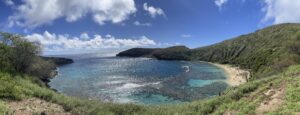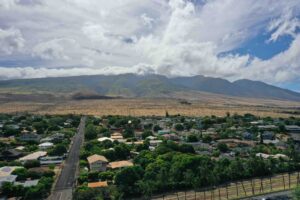BLOG POSTS ARE PRELIMINARY MATERIALS CIRCULATED TO STIMULATE DISCUSSION AND CRITICAL COMMENT. THE VIEWS EXPRESSED ARE THOSE OF THE INDIVIDUAL AUTHORS. WHILE BLOG POSTS BENEFIT FROM ACTIVE UHERO DISCUSSION, THEY HAVE NOT UNDERGONE FORMAL ACADEMIC PEER REVIEW.
By Steven Bond-Smith
The draft O‘ahu Comprehensive Economic Development Strategy (CEDS) for 2022-2026 is now out for public comment. The importance of the CEDS is highlighted by its requirement as a prerequisite for receiving funding from the Federal Economic Development Administration (EDA) under its Public Works and Economic Adjustment Assistance programs. It is also required to be designated as an Economic Development District. Draft CEDS documents for Hawai‘i’s other counties are expected shortly, followed by an over-arching CEDS for the state. Here are some suggestions for making Hawai‘i’s CEDS genuinely strategic.
An effective CEDS would both support a region’s strengths and identify areas of opportunity that are currently under-performing but would be expected to perform well in Hawai‘i. Examining opportunities carefully, the CEDS would be able to identify strategic initiatives and investments that address the reasons why these areas are under-performing, typically due to market or government failures. These are problems that the market doesn’t solve on its own or persist because regulations are not performing as intended. It is critical that the CEDS develops targeted initiatives in the most feasible areas of opportunity to avoid wasting funds on long-shot aspirations or spreading funds too thinly. O‘ahu cannot do everything, so should promote activities around its unique strengths. In addition, initiatives should enable the entrepreneurial discovery process to find the best ideas by addressing the market and government failures that have prevented economic development from occurring on its own. In this way, a CEDS should not pick winners, but enable the winners to emerge from competitive processes.
Unfortunately CEDS documents tend to be very broad, rather than being targeted or strategic. While this might enable flexibility, it means that funding is less likely to be used for a strategic purpose and may instead end up funding a pet project. As I wrote in a report in April last year “Location, Location, Location! A uniquely Hawai‘i economic development strategy,” the economic context for Hawai‘i is very different from other places because of its small scale and isolation, yet high level of economic integration. This leads to a highly specialized economy. Other industries face significant transaction costs that generate various coordination problems and prevent the development of a more diversified economy. The CEDS should target these types of issues in the most promising areas of opportunity. The most feasible opportunities will be those that are highly related to O‘ahu’s existing strengths. Notably, the opportunities that will be sustained well into the future are those that depend upon a unique O‘ahu resource, such as its location or climate.
O‘ahu’s CEDS lists six long-term goals for 2050:
1. A shared culture of aloha;
2. All residents are thriving;
3. Communities are at the heart of decision-making with trusted leadership;
4. Recovered ʻāina momona (abundant land) with healthy natural ecosystems;
5. Innovation and creativity are a way of life; and
6. A resilient O‘ahu.
These goals are honorable, but unfortunately they are not clearly measurable. In that sense, they are not really goals. Will anyone be able to look at those goals in 2050 and say that they were achieved? Why aren’t they more specific? Examples of more specific goals could include: specific measures for life-expectancy in all ethnic groups; 100% of residents covered by health insurance with low deductibles; community-based decision making within specific (ideally short) time-frames; specific measures of housing affordability, including specific targets for improving housing of Native Hawaiians; specific measures of reduced homelessness; specific measures of environmental quality and restoration; a target for employment of scientists and engineers and their output of patents; specific measures of innovation in service industries that are usually not patented; specific measures of renewable energy; specific shares of local food supply; specific targets for the relative cost of food; specific shares of waste recycled and targets for reducing waste in general; and specific measures of a diversified and resilient economy. Goals cannot be achieved if they are not measurable.
The flagship outputs of O‘ahu’s CEDS are its “2026 Objectives and Action Plan”. Some of this is much more targeted. The action to “reverse ecosystem loss by protecting at least 30% of native watershed forests and establishing at least 30% of near-shore areas as marine-managed areas by 2030” is measurable. But indeed it is an action rather than a goal. It is what the county will do, rather than what it hopes to achieve by doing it. And the overarching goal remains unmeasurable. Goals should be specific, but also allow competitive forces to determine the winning solutions.
Since regional productivity and growth are the key economic purpose of the CEDS, the most important component of O‘ahu’s CEDS appears to be its Objective 6: Diversify to build a resilient O‘ahu community. The CEDS chose eight “economic clusters”: Health & Wellness; Education & Innovation; Arts & Creativity; Hospitality & Reciprocity; Housing and Critical Services; Agriculture & Food Systems; Environment and Natural Systems; and Safety & Peace. An economic cluster is a group of interconnected businesses all located in the same place to increase productivity and innovation. Some of these chosen clusters may be excellent choices. There are clear strengths in health, hospitality, and the military. In a 2017 report “A New Perspective on Hawaii’s Economy: understanding the role of clusters,” UHERO similarly identified existing strengths in hospitality, performing arts, and transportation and logistics. There is a unique and authentic Hawai‘i theme in the Arts. Agriculture & Food used to be a strength that has all but disappeared. But just because it used to be here doesn’t mean it will return or that reviving it would bring down the cost of food. Instead, the feasible opportunities in agriculture and food will more likely be specific sub-sectors, such as tropical-agriculture, vertical and greenhouse farming, aquaculture, aquaponics, fisheries, and agri-tourism.
But the other “clusters” chosen in the CEDS such as environment, innovation, safety, and housing are not really economic clusters at all. Housing is a necessity for all residents. The environment is a critical and valuable resource of unique importance to Kānaka ʻŌiwi and Hawai‘i’s tourism industry, as well as critical for living on a small island in the middle of the ocean. All sectors should aim to foster innovation: innovation does not stand on its own, separate from other clusters. Education is indeed an industry, with a strong base in Honolulu, but the skills that it provides are also an enabler for all other industries. Public safety is a key enabler of economic activity. And similarly health enables healthy residents, in addition to being an area of economic opportunity. In that sense, housing, educating, keeping safe and keeping healthy should be seen as economy-wide enablers, rather than “clusters” or areas for diversification.
By separating out economy-wide enablers, the diversification objective can truly target its domains of opportunity. These might well include the Health industry, Education industry, Arts & Creativity; Hospitality and Accommodation; Agriculture & Food; and Defense as the strategic areas of interest, but the CEDS should also include objective evidence for why these sectors are selected.
And the CEDS should also be more specific about the areas of opportunity in these sectors. What areas of health and medicine might generate new exports for the state? What areas of the arts could O‘ahu develop? What new activities can build on O‘ahu’s existing strengths in Hospitality and Accommodation? What food crops or methods are likely to generate sufficient value added to be productive in Hawai‘i and competitive in mainland markets? And how can private businesses both participate in the Defense industry and transfer innovations in the Defense industry to external markets? Well defined areas of opportunity mean that initiatives can more effectively work towards those opportunities. Rather than broad, poorly targeted diversification industries in their own right, skills, and innovation would be themes for some of the types of initiatives within each and every targeted domain. A CEDS that is more focused on unique local opportunities will be far more likely to achieve well-specified goals for a diversified and resilient economy.
These and other initiatives must also have measurable goals and specific targets with monitoring, revision and improvement to make sure O‘ahu is truly diversifying as intended. If some initiatives or targeted areas are failing to meet their measurable goals, there must be the flexibility to abandon failing initiatives and introduce new ones. At the moment, within each noted cluster, there are a range of existing programs with little indication or evaluation about whether these are effectively targeting the barriers to development in the most promising areas of opportunity in those sectors. Finally, the evaluation and assessment tools focus on evaluating proposals, but offer no guidance about ongoing monitoring or revision.
Importantly, the CEDS initiatives must be careful not to “pick winners”. Guarantees and grants to specific businesses and investments in pet-projects will tend to favor the loudest voices and biggest smiles, but not incentivize productivity improvements. Instead, initiatives should support infrastructure, R&D and invest in enabling technologies and facilities that will be used by multiple entrepreneurs, so that competitive processes discover the most promising businesses for diversifying O‘ahu’s economy and stimulating productivity growth.






3 thoughts on “Is O‘ahu’s new Comprehensive Economic Development Strategy strategic enough?”
Hawaii needs cheap housing as well as affordable housing. Cheap as in under $200,000.00 for a family of four. This means looking into prefab, mobile and modular homes – we have plenty of land.
Hawaii needs to recognize it already has a one billion dollar Education business – Education as an export for students that come here to learn. We need to analyze this business and expand it. The opportunity here is greater than Ag, Tech, and Movies.
Thanks for the feedback. Yes it would be helpful if housing was generally more affordable across the price range. This would benefit people working in many different industries. Indeed, education could be an important export business ripe for expansion. Similarly there may be opportunities in Ag, movies, and particular areas of tech – But perhaps even more importantly than what areas are chosen, is the evidence for why those areas are chosen for support.
Where can I read more about all the program goals for 2050?